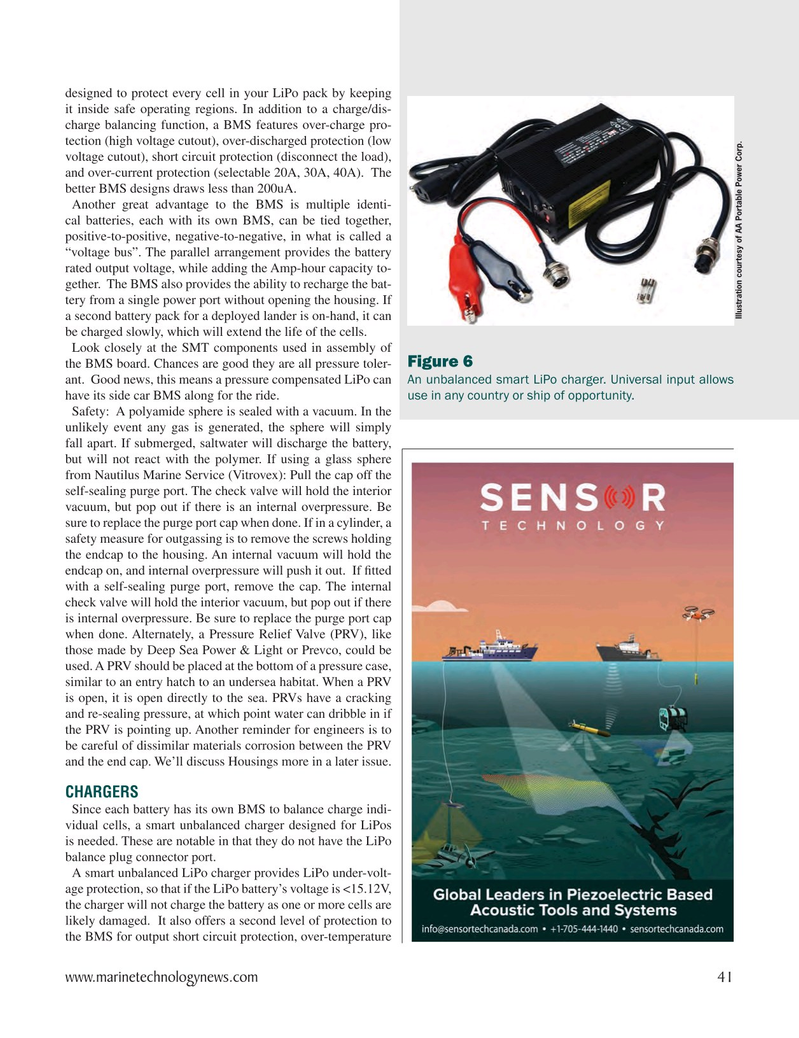
Page 41: of Marine Technology Magazine (November 2022)
Read this page in Pdf, Flash or Html5 edition of November 2022 Marine Technology Magazine
designed to protect every cell in your LiPo pack by keeping it inside safe operating regions. In addition to a charge/dis- charge balancing function, a BMS features over-charge pro- tection (high voltage cutout), over-discharged protection (low voltage cutout), short circuit protection (disconnect the load), and over-current protection (selectable 20A, 30A, 40A). The better BMS designs draws less than 200uA.
Another great advantage to the BMS is multiple identi- cal batteries, each with its own BMS, can be tied together, positive-to-positive, negative-to-negative, in what is called a “voltage bus”. The parallel arrangement provides the battery rated output voltage, while adding the Amp-hour capacity to- gether. The BMS also provides the ability to recharge the bat- tery from a single power port without opening the housing. If
Illustration courtesy of AA Portable Power Corp.
a second battery pack for a deployed lander is on-hand, it can be charged slowly, which will extend the life of the cells.
Look closely at the SMT components used in assembly of
Figure 6 the BMS board. Chances are good they are all pressure toler- ant. Good news, this means a pressure compensated LiPo can An unbalanced smart LiPo charger. Universal input allows have its side car BMS along for the ride. use in any country or ship of opportunity.
Safety: A polyamide sphere is sealed with a vacuum. In the unlikely event any gas is generated, the sphere will simply fall apart. If submerged, saltwater will discharge the battery, but will not react with the polymer. If using a glass sphere from Nautilus Marine Service (Vitrovex): Pull the cap off the self-sealing purge port. The check valve will hold the interior vacuum, but pop out if there is an internal overpressure. Be sure to replace the purge port cap when done. If in a cylinder, a safety measure for outgassing is to remove the screws holding the endcap to the housing. An internal vacuum will hold the endcap on, and internal overpressure will push it out. If ? tted with a self-sealing purge port, remove the cap. The internal check valve will hold the interior vacuum, but pop out if there is internal overpressure. Be sure to replace the purge port cap when done. Alternately, a Pressure Relief Valve (PRV), like those made by Deep Sea Power & Light or Prevco, could be used. A PRV should be placed at the bottom of a pressure case, similar to an entry hatch to an undersea habitat. When a PRV is open, it is open directly to the sea. PRVs have a cracking and re-sealing pressure, at which point water can dribble in if the PRV is pointing up. Another reminder for engineers is to be careful of dissimilar materials corrosion between the PRV and the end cap. We’ll discuss Housings more in a later issue.
CHARGERS
Since each battery has its own BMS to balance charge indi- vidual cells, a smart unbalanced charger designed for LiPos is needed. These are notable in that they do not have the LiPo balance plug connector port.
A smart unbalanced LiPo charger provides LiPo under-volt- age protection, so that if the LiPo battery’s voltage is <15.12V, the charger will not charge the battery as one or more cells are likely damaged. It also offers a second level of protection to the BMS for output short circuit protection, over-temperature www.marinetechnologynews.com 41
MTR #8 (34-49).indd 41 11/28/2022 6:07:24 PM

 40
40

 42
42
